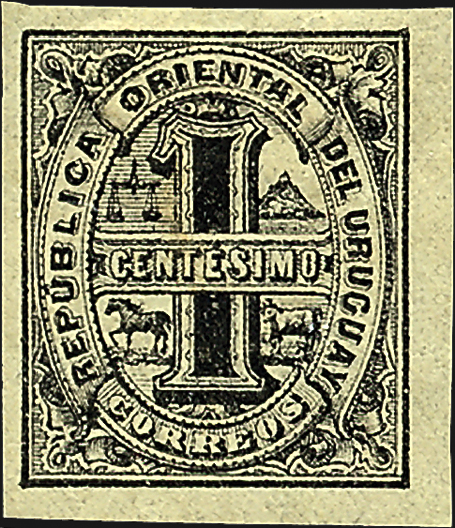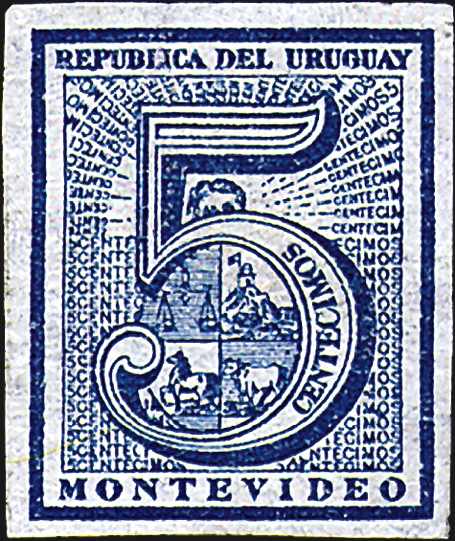World Stamps
Classic Stamps of the World: Large numeral issues brought fine printing to Uruguay’s stamps
As is often the case in stamp-issuing practice, a change in postal rates prompted a new set of stamps in 1866 in Uruguay, a very small nation in southeastern South America.
Originally a Spanish colony, Uruguay became independent in 1811 but did not organize a national postal system with government-issued postage stamps until 1859.
On Sept. 6, 1865, Uruguay’s minister of finance issued a lengthy decree containing 47 articles, seven of which referred to postal matters.
Domestic and international rates were set, and article 41 stated that stamps “of the value of 5, 10, 15, and 20 centesimos” would be issued to meet the new rates.
These four stamps were being engraved and printed by lithography in England by Maclure, Macdonald and Co. of London and Glasgow, “Ornamental Printers to the Queen,” and inventors of a power-driven lithographic printing press in 1853.
The company seems to have printed one group of the new issues and then sent the engraving stone and paper to Montevideo so that further examples of the stamps could be printed domestically.
The new stamps were to be issued Jan. 1, 1866, but production delays meant that they were not in hand for the scheduled first day. As an emergency measure, the first overprinted stamps in South America were created, when Uruguay issues of 1864 were surcharged (Scott 24-28) and released Jan. 1.
The four new designs (Scott 30-33) were delivered from England in time for release on Jan. 10. Each of the four is a variation on a theme of a large numeral in the center for the denomination with Uruguay’s coat-of-arms in a quadrant in the background. The four portions of the arms depict scales symbolizing justice; a fortress on a hill symbolizing strength and recalling the arms of Montevideo, the country’s founding city and later the capital; a galloping horse evoking freedom; and an ox for hard work and abundance.
The quirky member of this set is Scott 29, a 1c issue. The edict of September 1865 decreed the creation of a “journal or printed matter” rate of 1c per piece. Books and pamphlets would be charged 1c per ounce.
At that time, Uruguay had no 1c stamp; the lowest denomination available would be the 5c on 12c surcharged stamp issued Jan. 1, 1866, pending the arrival of the new 5c stamp.
Fast forward to Sept. 3, 1866, when official records show that the administrator-general of posts, Alexandro Gutierrez, wrote to the minister of the interior, indicating that the “posting of pamphlets had increased to such an extent that it was difficult to maintain a regular service” (according to Emanuel J. Lee, The Postage Stamps of Uruguay, 1931).
Seemingly ignoring the fact that the edict of September 1865 had specified rules and rates for newspapers and printed matter, a year later Gutierrez was asking for permission to begin charging 1c for the service. The interior minister replied the following day and granted the request, saying that “the tax proposed by you is too insignificant to make it irksome for the public and in order that the newspapers should be delivered regularly.”
Gutierrez quickly implemented the decision, announcing that, “from the 1st of October next 1 centesimo must be paid for each newspaper despatched through the Post Offices of the Republic. Books, pamphlets and other printed matter will have to be paid for according to their weight. The only exceptions will be those sent abroad by the English and French mailboats.”
According to a 1978 book by the Direccion Nacional de Correos Uruguay (the postal administration), the 1c stamp was engraved and printed in London in a quantity of “about 400 thousand” and issued Oct. 1, 1866.
Like the four issues of Jan. 1, the 1c design features a large numeral and a background of elements of the national coat of arms, but the design has an oval containing the full official name of the country, “Republica Oriental del Uruguay,” and the word “correos” (post or mail).
“Republica Oriental” means “Eastern Republic” and refers to Uruguay’s location to the east of the Uruguay River. This was the first stamp of Uruguay to have the country’s official name in full; wording on the earlier stamps stated “Republica del Uruguay” and also “Montevideo.” The new 1c issue also has ornate design elements in the four corners of the stamp.
The 1c was produced in black ink in two identifiable types, listed in the Scott Classic Specialized Catalogue of Stamps and Covers 1840-1940 as Scott 29 (type II) and 29a (type I), type I being the clearer, more distinct printing, with wider spacing (4mm) between the stamps than on type II (3mm).
Various experts have stated, based on examples of the 1c in their possession, that there were two different lithographic stones for the issue, not merely two printings from the same stone.
One stone (type I) produced two panes of 72 stamps each, and the second (type II) had 16 rows of 11, for 176 stamps. Type II was printed on a fine-quality paper produced in Maidstone, Kent, England, with a watermark that reads “Original/Turkey/Mill/1865.” The watermark is centered in each sheet so it appears on a limited number of stamps. All of the 1c stamps were issued imperforate.
There seems to be no record of the designer of the 1c stamp, but Gutierrez, the administrator-general of the posts, had personally drawn some suggested designs (which were closely followed by the printing firm) for the four stamps issued on Jan. 10, 1866. As he was the guiding force behind the new 1c stamp, it is not unreasonable to think that he again offered suggestions for the design of this issue.
Echoing the conclusions of a number of Uruguay specialists in the past, an unsigned article in Weekly Philatelic Gossip of April 13, 1940, stated that the 1c “is really a fiscal stamp, and on a similar footing with the newspaper stamps of Austria. There is, of course, a possibility that some were used postally.”
If so, a quantity would have been needed on the mailpiece to meet the 5c, 10c, 15c or 20c prevailing postal rates.
The 2015 Scott Classic specialized catalog values Scott 29 and 29a identically: $5 for mint examples and $7.50 for used. Yes, used examples are valued at more than mint, so be careful to determine that the cancel on a Uruguay Scott 29 or 29a intended for your collection is genuine, and not a fraudulent addition to increase the price.
More from Linns.com:
‘Strange Stamp Squad' investigates migraine-inducing new issue
Many stamp societies make their journals available online
British Honduras World War I stamps with moire overprints
A new look for royal definitives from three countries
Canada’s Maple Leaf flag celebrates 50th anniversary
Keep up with all of Linns.com's news and insights by signing up for our free eNewsletters, liking us on Facebook, and following us on Twitter.
MORE RELATED ARTICLES
Headlines
-
Postal Updates
Oct 7, 2024, 5 PMUSPS plans to raise postal rates five times in next three years
-
US Stamps
Oct 7, 2024, 3 PMMcMurtrie dismissed as APS education director following Sept. 21 arrest
-
US Stamps
Oct 7, 2024, 12 PMVasiliauskas named president of Mystic Stamp Co.
-
US Stamps
Oct 6, 2024, 5 PMApgar souvenir card available







